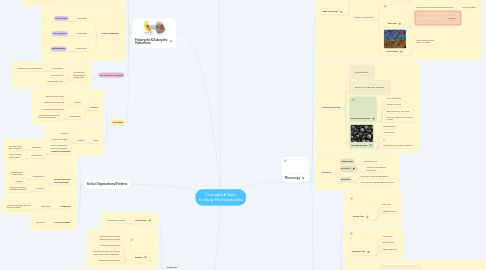
1. Overview
1.1. Prokaryotic
1.1.1. Homeostasis
1.1.1.1. Associative Learning
1.1.2. Biofilms
1.1.2.1. Cell interaction through multicellular association
1.1.2.2. Highly organized state
1.1.2.3. Extracellular matrix of proteins, sugars, and other substances
1.1.2.4. Impervious to antibiotics
1.1.3. Quorum Sensing
1.1.3.1. Cell communication
1.1.3.1.1. Chemical
1.1.3.2. Can be used to sense numbers
1.1.3.2.1. Keep tabs on each other
1.1.3.3. Examples
1.1.3.3.1. Cystic Fibrosis
1.1.3.3.2. Otitis Media (Ear Infection
1.1.3.3.3. Tooth Decay
1.2. Eukaryotic
1.3. Similarities
1.3.1. DNA controls structure and point
1.3.2. Response to stimuli
1.3.3. Biochemical Reactions
1.3.3.1. Occur in H2O
1.3.3.2. Growth + Energy
1.3.4. Adaptation
1.3.4.1. Through mutation, learning
1.3.5. Interaction
1.3.5.1. w/ organisms and environment
2. Similar Organizational Patterns
2.1. Genetic Organization
2.1.1. Eukaryotes
2.1.1.1. Multiple, linear chromosomes
2.1.2. Prokaryotes
2.1.2.1. Single, circular chromosome
2.2. Compartmentation (Cell Membrane)
2.2.1. Components
2.2.1.1. Phosphilipids (Lipid Bilayer
2.2.1.2. Proteins
2.2.2. Function
2.2.2.1. Allow exchange of solutes ans wastes
2.3. Metabolism
2.3.1. Cytoplasm
2.3.1.1. Chemical reactions and ATP (insert link here)
2.4. Protein Synthesis
2.4.1. Ribosome
3. Prokaryotic & Eukaryotic Distinctions
3.1. Endomembrane System (In Eukaryotes)
3.1.1. Endoplasmic Reticulum
3.1.1.1. Rough ER
3.1.1.1.1. Protein Synthesis & Transport
3.1.1.2. Smooth ER
3.1.1.2.1. Lipid Synthesis & Transport
3.1.2. Golgi Apparatus
3.1.2.1. Packaging proteins and lipids
3.1.2.1.1. Come from ER
3.1.3. Lysosomes
3.1.3.1. Digestive enzymes
3.1.3.1.1. Breaks down foods
3.1.3.2. Comes from Golgi Body
3.2. Endomembrane Alternative (In prokaryotes)
3.2.1. Proteins lack endomembrane system
3.2.1.1. Can manufacture/modify proteins
3.2.2. Microcompartments
3.2.2.1. Carry out chemical reactions
3.2.2.2. Protect cell from toxic products from reactions
3.3. Energy Metabolism
3.3.1. Eukaryotes
3.3.1.1. Mitochondria
3.3.2. Prokaryotes
3.3.2.1. Cell Membrane
3.3.3. Chloroplasts
3.3.3.1. Photosynthesis
3.4. Cell Structure & Transport
3.4.1. Cytoskeleton (Eukaryotes & Prokaryotes)
3.4.1.1. Microtubules
3.4.1.1.1. Originates from centrosome
3.4.1.2. Microfilaments
3.4.1.3. Intermediate Fiber
3.5. Cell Motility
3.5.1. Flagella
3.5.1.1. Protists
3.5.1.1.1. Back & Forth Motility
3.5.1.1.2. Beating back and forth
3.5.1.1.3. Thin protein projections
3.5.1.2. Prokaroyotes
3.5.1.2.1. Rotational propeller=like force for movement
3.5.2. Cilia
3.5.2.1. Protists
3.5.2.1.1. Shorter
3.5.2.1.2. More than flagella
3.5.2.1.3. Wave in synchrony, propel cell forward
4. Methods to Identify Microorgranisms
4.1. Physical Cahracteristics
4.1.1. Spore-forming abiity
4.1.2. motility
4.1.3. Ocygen, pH, grwoth temperature
4.2. Biochemical Tests
4.2.1. Fermentation
4.2.2. Uses of specific substrate
4.2.3. Key flow chart
4.3. Serological Tests
4.3.1. Antigen-antibody reactions
4.4. Nucleic Acid Analysis
4.4.1. Molecular genetics and genomes
5. Microscopy
5.1. Light Microscopy
5.1.1. Used to observe most organisms
5.1.2. Lenses
5.1.2.1. Low-Power
5.1.2.2. High-power
5.1.2.3. Oil-immersion
5.1.3. Optical Configurations
5.1.3.1. Phase-contrast
5.1.3.1.1. Special condenser to see living, unstained
5.1.3.1.2. Living!!
5.1.3.2. Dark-field
5.1.3.2.1. Shows specimen against dark background
5.1.3.2.2. Treponeme pallidum
5.1.3.3. Fluorescence
5.1.3.3.1. Coated with glo-dye seen in UV light
5.2. Electron Microscopy
5.2.1. 2nm Resolution
5.2.2. Electrons are absorbed, reflected,
5.2.3. Transmission Electron
5.2.3.1. 200K Resolution
5.2.3.2. Ultrathin section
5.2.3.3. Best resolution, best mag.
5.2.3.4. Used to: internal components, viruses
5.2.4. Scanning Electron
5.2.4.1. 20k resolution
5.2.4.2. Unsectioned
5.2.4.3. 3D
5.2.4.4. Used to examine surface features
5.3. Properties
5.3.1. Magnification
5.3.1.1. Increase of size
5.3.2. Resolution
5.3.2.1. Ability to see separate two points
5.3.3. Refraction
5.3.3.1. Measure of light-bending ability
5.3.3.2. Oil-immersion reduces light refraction
5.4. Staining techniques
5.4.1. Simple Stain
5.4.1.1. Basic dye
5.4.1.2. Methylene Blue
5.4.2. Negative Stain
5.4.2.1. Acidic duye
5.4.2.2. Nigrosine Ink
5.4.2.3. Dark backgrouns
5.4.3. Gram Stain
5.4.3.1. Safranin used as counter stain
5.4.3.2. Gram-positive
5.4.3.2.1. Retain crystal violet
5.4.3.2.2. More peptidoglycan
5.4.3.2.3. Peptidoglycan cannot be washed off
5.4.3.2.4. Purple - Positive
5.4.3.2.5. Acid-Fast
5.4.3.3. Gram-negative
5.4.3.3.1. Do not retain crystal violet
5.4.3.3.2. Less peptidoglycan
5.4.3.3.3. Cell wall can be dissolved by alcohol
5.4.3.3.4. Red - Negative
5.4.4. Spore Stain
5.4.4.1. Endospore is stained
5.4.4.2. Hard shell is not usually stained
